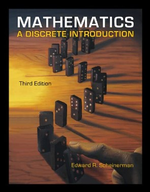Reverse Polish Notation. We remarked at the beginning of this section that
Chapter 40, Problem 40.21(choose chapter or problem)
Reverse Polish Notation. We remarked at the beginning of this section that mathematicians usually put the operation symbol between the two objects (operands) to which the operation applies. There is, however, an alternative notation in which the operationsymbol comes after the two operands. This notation is called reverse Polish notation(RPN for short) or postfix notation. For example, in RPN, instead of writing 2 C 3, wewrite 2 3 C.Consider the RPN expression 2; 3; 4; C;. There are two operation symbols, andeach operates on the two operands to its left. What do the C and operate on? TheC sign immediately follows 3; 4, so it means to add those two numbers. This reducesthe problem to 2; 7;. Now the operates on the 2 and the 7 to give 14. Overall, theexpression 2; 3; 4; C; in standard notation is 2 .3 C 4/.On the other hand, the RPN expression 2; 3; C; 4; stands for .2 C 3/ 4, whichevaluates to 20.Evaluate each of the following.a. 1; 1; 1; 1; C; C; C.b. 1; 2; 3; 4;; C; C.c. 1; 2; C; 3; 4;; C.d. 1; 2; C; 3; 4; C;.e. 1; 2; C; 3; C; 4;.40.23. RPN
Unfortunately, we don't have that question answered yet. But you can get it answered in just 5 hours by Logging in or Becoming a subscriber.
Becoming a subscriber
Or look for another answer
